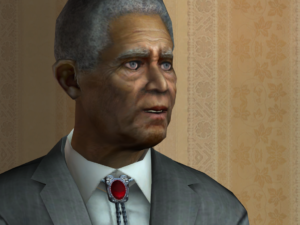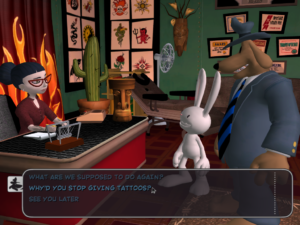CSI: Comparisons
 CSI: Hard Evidence was apparently made using the same development tools as the Sam and Max and Bone games, but it’s a real contrast in style. For that matter, Sam and Max is pretty different from Bone: wisecracking cynicism and urban decay vs. good-natured fantasy, as well as the contrast in puzzle style mentioned previously. But Sam and Max and Bone are both ultimately cartoons, rendered in a cartoony style. CSI, although pretty close to a cartoon in its exaggerated and stylized story content, tries to be realistic in its visual appearance, including human figures. And this, if you ask me, is one of its weak points. The regulars from the show are passable, but per-episode characters — the victim and suspects — live farther down in the uncanny valley. Mouths in particular seem troublesome, and tend to bunch up in odd ways when characters is talk.
CSI: Hard Evidence was apparently made using the same development tools as the Sam and Max and Bone games, but it’s a real contrast in style. For that matter, Sam and Max is pretty different from Bone: wisecracking cynicism and urban decay vs. good-natured fantasy, as well as the contrast in puzzle style mentioned previously. But Sam and Max and Bone are both ultimately cartoons, rendered in a cartoony style. CSI, although pretty close to a cartoon in its exaggerated and stylized story content, tries to be realistic in its visual appearance, including human figures. And this, if you ask me, is one of its weak points. The regulars from the show are passable, but per-episode characters — the victim and suspects — live farther down in the uncanny valley. Mouths in particular seem troublesome, and tend to bunch up in odd ways when characters is talk.
More than that, though, Sam and Max and Bone are both based on the Sierra/Lucasarts paradigm: you have an avatar who walks where you click. CSI uses something more like a Myst-style interface. Movement between scenes is handled through a “locations” menu in your PDA (which also holds the inventory, options menu, and case details), but movement within a scene is handled through clickable hotspots. But the scene itself is rendered in 3D, and even without clicking, you can do some limited shifting around by means of the mouse — or, presumably, the right analog stick in the console versions, which seems like a better fit to the mode of interaction here. It’s not quite like any other game I’ve seen: the closest is Myst V in “panning” mode, but there, the panning was always just a matter of changing the camera’s orientation, not its position. Here, you can use the mouse to do things like circle a car and inspect it from all sides, if that’s the motion that’s scripted for that node.
Disclosure: I received this game for free from Telltale Games.
 Comments(0)
Comments(0)